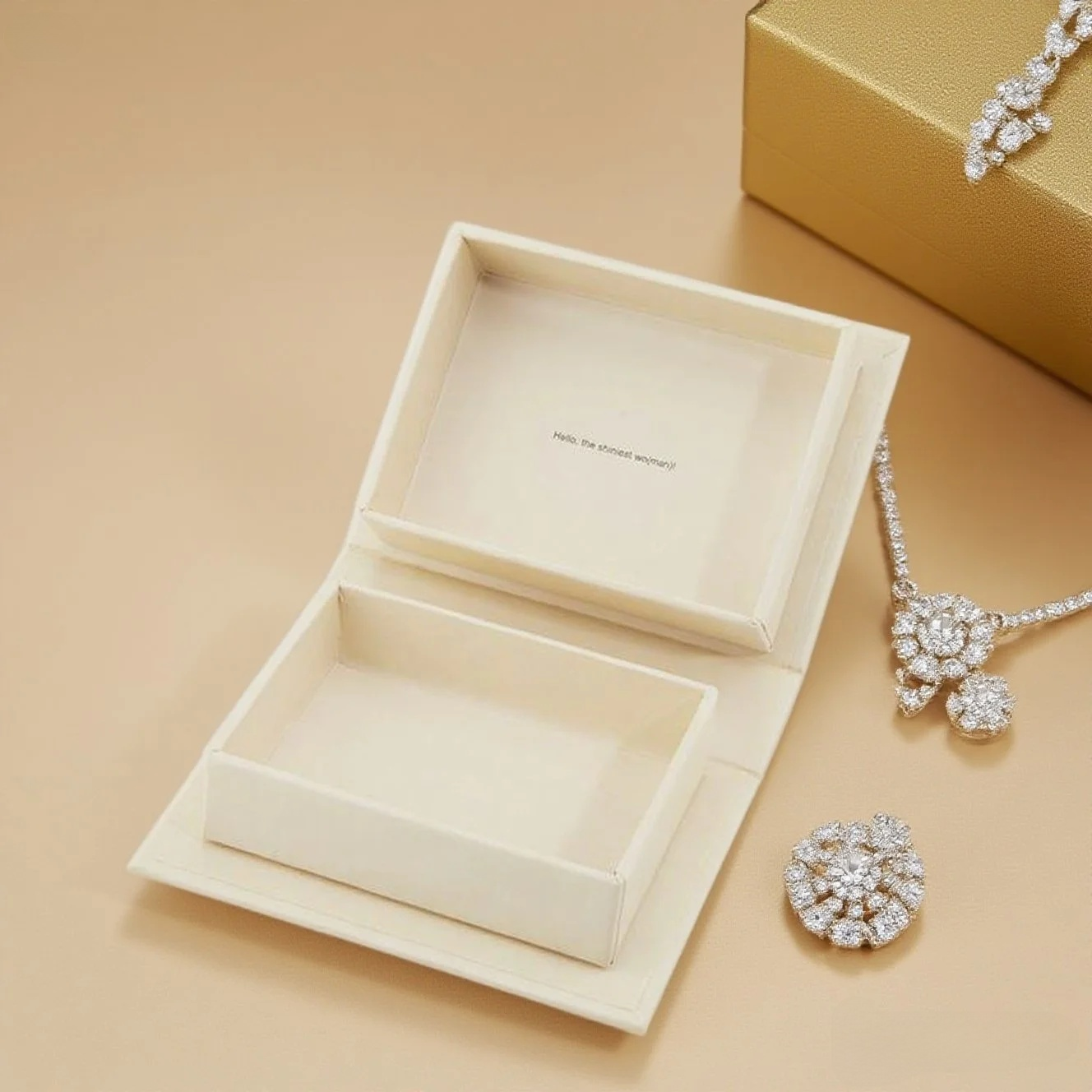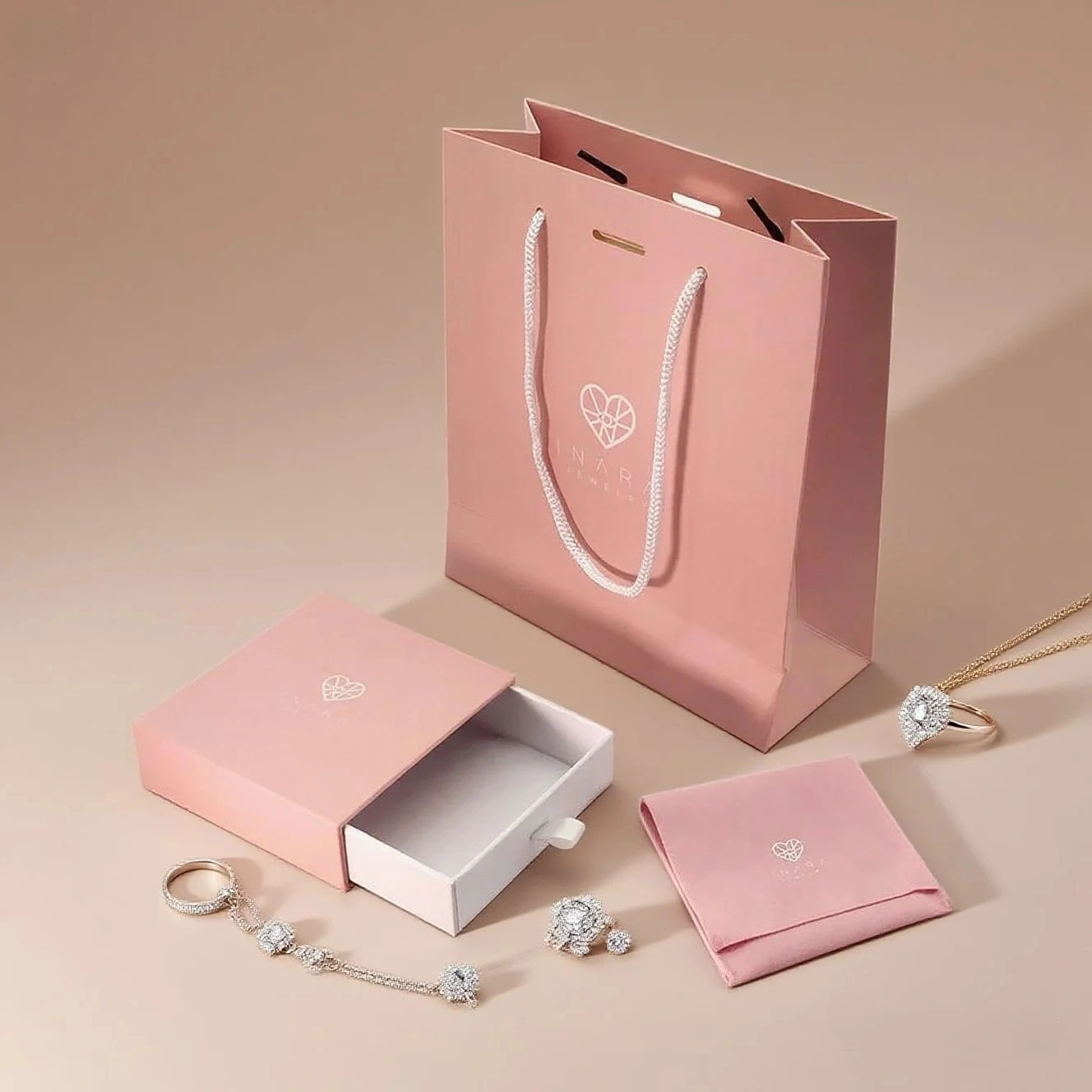Enhancing the Value of Jewelry Packaging
When a customer receives an item, the packaging shapes their first impression. Thoughtful packaging that balances practicality and beauty elevates the perceived value of the jewelry inside. Beautiful presentation conveys care, quality, and brand personality, while practical features ensure the piece arrives safely and remains secure over time. Packaging that is aesthetically pleasing delights the recipient, creating a memorable experience and reinforcing brand loyalty. Practical considerations such as cushioning, durability, and secure closures prevent damage and maintain presentation integrity throughout delivery and storage. By merging form and function, jewelry packaging supports both customer satisfaction and operational efficiency, making it essential for brands that aim to stand out and build trust.
Protecting Jewelry and Building Brand Image
How Practical Protection Enhances Trust
Jewelry packaging must prevent scratches, dents, or tarnishing during transit and handling. Using foam inserts or soft lining protects delicate pieces, while sturdy construction prevents deformation. Strong closures—magnets, snaps, or ribbons—keep contents secure. When brands prioritize protection, they signal attention to quality and reliability. These practical elements reduce returns or damage claims and strengthen brand credibility. Customers who receive jewelry intact appreciate the care taken, reinforcing their confidence in the brand. Practical design choices such as resealable boxes and protective pouches also support long‑term use. Caring customers are more likely to reuse packaging, creating positive brand associations over time. Practical packaging becomes part of the customer relationship, not just a container.
Aesthetic Design That Resonates Emotionally
Beautiful jewelry packaging speaks to the emotional connection between the product and the gift. Elegant color choices, textured materials, and refined finishes create a sense of luxury. Embossing or foil stamping with logos or motifs reinforces brand identity. The exterior design sets expectations for what’s inside, making the unboxing an experience rather than a task. Well‑designed packaging triggers delight, and such emotional responses increase the perceived value of the jewelry. Luxury brands often use thematic packaging—seasonal patterns or limited‑edition designs—to make the experience even more personal. Beautiful packaging becomes keepsake-worthy, reminding recipients of special occasions. This emotional resonance leads to social sharing and word-of-mouth recommendations, enhancing brand visibility and customer retention over time.
Functional Features That Support Practical Use
Convenience and Reusability in Jewelry Packaging
Functional packaging includes thoughtful features like hinged lids, compartments, or travel-friendly pouches. A box that opens easily and can be reclosed securely encourages reuse. Compartments help organize multiple items—such as earrings plus a necklace—without tangling. Reusable packaging adds value for customers because it becomes part of their daily routine. Practical organization reduces clutter in storage and maintains the beauty of the pieces long after purchase. Brands that emphasize reusability send an eco-conscious message and align with sustainability trends. Including features like compactness and stackability also supports efficient storage and shipping. When packaging remains functional after purchase, it extends the brand experience and supports long-term customer loyalty.
Logistical Considerations and Cost Efficiency
Practical jewelry packaging must support shipping and storage without adding unnecessary weight or bulk. Lightweight yet sturdy materials—such as corrugated inserts or kraft boards—reduce shipping costs while protecting contents. Stackable designs optimize warehouse space. Breakaway elements, tear strips, or reinforced corners improve durability in transit lines. Easy assembly and minimal packaging assembly time reduce operating labor costs. Brands that design packaging with shipping logistics in mind deliver products intact and efficiently. Practical optimization ensures that the brand’s beauty does not come at the expense of cost or environmental impact. Efficient packaging design supports both customer delight and business sustainability.

Sustainability and Ethical Considerations
Eco‑Friendly Materials in Jewelry Packaging
Choosing recyclable, biodegradable, or responsibly sourced materials signals environmental responsibility. Packaging made from recycled paper, natural fibers, or minimal plastic aligns with modern consumer values. Sustainable choices reduce waste and help brands reduce ecological footprints. Clean branding messages—such as “100% recyclable box” or “plastic‑free packaging”—resonate with ethically-minded customers. Sustainable materials can also be beautiful—kraft boxes with elegant embossing or soft-touch finishes combine environmental friendliness with premium appearance. Brands that invest in eco-design reflect a forward-thinking ethos and build loyalty among conscious consumers. Jewelry packaging that is sustainable and beautiful becomes a tangible proof point of brand integrity.
Minimalist Design That Reduces Waste
Functionality and beauty can converge in minimalist design. Carefully designed packaging minimizes excess—small boxes sized to the product, simple closures, limited inserts. Minimal design reduces material use, lowers shipping weights, and simplifies recycling. At the same time, minimalist aesthetics—clean lines, neutral palette, subtle branding—convey modern elegance. This streamlined approach supports both sustainability and unboxing experience. A minimalist box that feels solid yet understated can appear more refined than overly elaborate packaging. Reducing waste in design reflects operational efficiency and environmental responsibility. Brands that embrace minimalist packaging demonstrate alignment with current sustainability trends while retaining aesthetic appeal.
Customization and Personal Touch
Personalized Details That Create Emotional Resonance
Adding personalized touches such as printed recipient names, handwritten notes, or custom gift wrapping elevates the unboxing experience. Personalized jewelry packaging makes a gift feel unique and carefully chosen. In addition to decorative liner paper, ribbons with brand colors or slips with care instructions add meaning. These details enhance emotional engagement and increase the perceived value of the gift. Customers appreciate when a brand goes beyond standard packaging to offer a curated, tailored experience. Custom touches also encourage social sharing and repeat business. When recipients feel recognized, they are more likely to form positive emotional associations with the jewelry and the brand.
Brand-Coherent Packaging That Tells a Story
Consistent packaging—reflecting the brand’s design language, color palette, and motifs—reinforces a cohesive brand narrative. High-end brands may use velvet inlays, soft fabrics, or luxurious embossing, while artisan brands favor earthy textures and organic finishes. These material choices reflect brand values and tell a story. Visual and tactile consistency builds brand recognition over time. Packaging becomes part of the brand identity, enhancing recall and customer loyalty. When jewelry packaging aligns with core brand personality—romantic vintage, modern minimalist, eco-luxury—it feels authentic. Beautiful and practical packaging works in concert to echo brand stories and draw customers into a deeper experience.
Security Features That Ensure Peace of Mind
Protective Elements That Preserve Product Integrity
Jewelry packaging must securely protect delicate contents—chains, stones, or fragile metals—against movement or impact. Insert elements such as foam, cloth pouches, or molded trays cushion pieces and prevent shifting. Secure closures like snaps or magnetic lids prevent accidental openings. Tamper-evident seals add security during transit. These practical features reduce risk of damage during handling. Packaging that prioritizes safety supports warranty claims and return trust. When customers receive items in impeccable condition, they appreciate the care taken. The protective benefits of practical design reassure customers and reinforce brand reliability.
Tamper-Detection and Authentication Features
In premium jewelry packaging, tamper-evident elements enhance trust. Seals, holographic stickers, or QR codes inside boxes confirm authenticity. These features deter tampering and indicate whether the product has been previously opened. Brands offering these measures support trust, especially in high-value or branded jewelry. Reliable authentication confirms the legitimacy of the piece. Packaging that integrates practical security with elegant design adds both aesthetic and functional value. This builds customer assurance and protects the brand’s reputation. Combined with beautiful presentation, security features create a holistic package that delights and reassures.
Operations and Production Efficiency
Scalable Packaging Solutions That Support Growth
Jewelry packaging must balance bespoke presentation with efficient production. Modular inserts, batch-printable sleeves, and scalable parts support growing order volumes. Streamlined assembly reduces labor costs while maintaining consistent branding. Beautiful designs should not compromise speed of fulfillment. When packaging is easy to assemble and customizable, brands scale without sacrificing quality. Practical packaging supports volume orders while preserving design integrity. Production-friendly packaging supports e-commerce, in-store gifting, and promotional runs with minimal waste or error. Scalability ensures that practical beauty remains viable at all business stages.
Cost‑Effective Material Sourcing Without Losing Aesthetic
Balancing quality and cost is critical in high-volume jewelry packaging. Selecting materials that are elegant yet affordable—such as high-grade cardstock versus full wood—makes beauty accessible. Bulk sourcing of ribbons, foam liners, or printed sleeves reduces unit cost. Supplier partnerships ensure consistent quality and cost control. Smart material selection allows brands to offer premium-feeling packaging at manageable cost. This cost efficiency ensures sustainability without compromising design standards. Practical material choices support operational viability and customer delight, ensuring that aesthetics enhance rather than escalate costs.
Market Differentiation and Customer Perception
Creating an Experience That Sets Brands Apart
In an increasingly competitive jewelry market, packaging that is both functional and beautiful offers a distinct advantage. Thoughtful presentation differentiates brands, making them memorable to customers. Practical yet elegant packaging becomes part of the overall experience, influencing reviews and referrals. A strong packaging identity supports brand storytelling and sets expectations for quality. Brands that deliver packaging that feels thoughtful—even before the jewelry is revealed—create loyal customers. Jewelry packaging that balances practicality and beauty becomes a strategic asset in the marketplace.
Influencing Purchase Behavior Through Presentation
Customers often judge value before seeing the product itself, assessing the packaging as part of the buying decision. When jewelry packaging looks refined and serves a clear practical purpose it reinforces the buying decision. Gifts also feel more meaningful when they arrive in beautiful presentation boxes. This psychological influence increases satisfaction and reduces purchase regret. Investing in high-quality packaging can boost conversion rates and order totals. Beautiful and practical packaging thus directly affects sales performance and long-term customer loyalty.
FAQ
Why should jewelry packaging be both practical and beautiful
Jewelry packaging that combines durability, protection and functionality with aesthetic design enhances customer satisfaction It protects the product while creating emotional appeal and brand recognition
How does practical packaging reduce damage or returns
Secure inserts foam cushions and reliable closures prevent jewelry from shifting or getting scratched during transit Reducing damage helps minimize returns and supports customer trust
Can packaging design impact customer perception of brand value
Absolutely Beautiful packaging elevates perceived value and emotional resonance Customers remember brands that present beads and metals thoughtfully and visually
What materials create practical yet attractive jewelry packaging
Materials such as high‑quality cardstock foam liners satin ribbons recycled paper or textile inlays offer both visual elegance and protective function while being cost efficient
Table of Contents
- Enhancing the Value of Jewelry Packaging
- Protecting Jewelry and Building Brand Image
- Functional Features That Support Practical Use
- Sustainability and Ethical Considerations
- Customization and Personal Touch
- Security Features That Ensure Peace of Mind
- Operations and Production Efficiency
- Market Differentiation and Customer Perception
- FAQ



